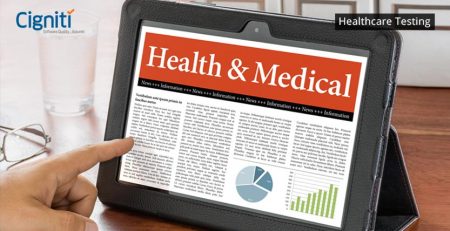Ensuring viability of the digital twin technology in Healthcare
In a typical episode of House M.D., a patient comes in with an unusual and puzzling condition, which Dr. House and his team try to figure out. Based on their traditional brainstorming session for identifying the possible causes and demystifying the puzzling condition, they strategize a treatment plan. The plan, that was carefully formulated based on the team’s expertise, understanding, and experience, backfired on more than one occasion due to an underlying, undetected, invisible symptom. By the time doctors figure out the actual cause, the case begins to slip out of their hands – forcing them to gear into the emergency mode. The plan, a cumulative result of medical experience, knowledge, and expertise, was more or a less an outcome of a guessing game – a gamble that puts a patient’s life on the line.
This scenario is not just for the sake of a television series. In fact, it is how healthcare practitioners mostly operate. They rely on their instinct that they have developed from years of medical practice. Digital twin technology in healthcare intends to transform the instinctive processes of delivering into data-driven processes, eliminating the ‘guess’ factor from the equation. A digital twin in healthcare is a patient’s in-silico representation, developed using the life-long data record of the individual. This data may come from wearable devices, Electronic Medical Records (EMRs), or any other source. Having this mirror image of the physical beings, medical practitioners can accurately determine the effectiveness of their prescribed solutions and treatments without jeopardizing with the patients’ lives.
Conventionally, the manufacturing and automotive industry have used digital twins for improving their process efficiency and reducing the costs. Now, as the technology is being introduced to the healthcare sector, we can expect to see exceptional improvement in patient care and cost-effectiveness. And, the technology is not only limited to patient care, but it also extends to equipment maintenance and overall hospital operations as well.
Digital twins of medical devices
Medical devices simulation allows the device manufacturers to test it under various environmental conditions without incurring additional costs. Researchers and engineers can identify the possible design deficiencies in the early stages of prototyping using the simulated model of a medical device. Additionally, they can understand how the device will behave under real-life conditions by making its simulated model interact with the 3D models of human anatomy. Leveraging digital twin technology in medical devices manufacturing not only enhances the design efficiency but also improves regulatory compliance. Medical devices testing is crucial for developing a robust and reliable product that is verified and validated on the compliance regulations.
Digital twins of hospitals
Healthcare industry has more variable in action than any other sector, which is why it often gets challenging to form an accurate care strategy for capacity planning. Healthcare organizations like John Hopkins Medicine (JHM) and General Electric (GE) are applying simulation and analytics to mitigate the variability factor. Having a ‘digital twin’ of their organization, they can make informed decisions regarding staffing, investments, and capacity. The digital twin or the simulated model offers a low-risk environment to the healthcare practitioners for testing out their proposed strategies and their impact on the hospital operations. It is majorly effective in dealing with the several intricacies of the conventionally-siloed and complex healthcare units as it collects and collates data from several disparate sources across the organization.
Digital twins for care delivery
If Dr. House and his team had the digital twin technology at their disposable, they could accurately predict the outcomes of a proposed treatment for their patient’s perplexing medical condition. There would be lesser drama, higher efficiency, and better care delivery. Certainly, with no scope for unanticipated twists, the show would not be as interesting. But, being aware of the perils of unknown medical conditions and the risks of ‘probably’ successful treatments, digital twin technology seems necessary. The in-silico models of human anatomy powered by Artificial Intelligence and real-time data allow the healthcare providers to test the feasibility of the treatment plan without exposing the patient to any fatal risks. This is especially helpful in patients with low-risk-tolerance requiring high-risk surgeries or procedures.
Challenges facing the digital twins
The data-dependency of digital twins against each individual raises serious challenges in terms of reliability, accuracy, and storage of the generated information. The data generated from various sensors and IoT devices need to interact with various algorithms to develop an effective simulated model. The performance of these algorithms is directly related to the quality of available data. In order for the digital twin to be of the highest accuracy, there should be a continuous generation of data and moreover, continuous integration of data with the algorithms. Outdated data or inaccurate data may result in a faulty twin, which will subsequently provide incorrect outcomes, leading to fatal consequences.
Ensuring the viability of digital twin technology
The AI-driven algorithms behind digital twins should be capable of identifying anomalies in an individual’s lifestyle choices or behavior, correlating different clinical events with one another, registering responses and reactions to a particular medicine, and processing all this information correctly. While these algorithms and the resulted digital twins empower healthcare practitioners to test before they act, the technologies themselves need to be tested for quality and viability.
The variables of the physical world incorporated within a digital twin necessitates utilization of Artificial Intelligence and Machine Learning for quality assurance and testing. As digital twins rely on a larger IoT ecosystem, it is essential to guarantee flawless coordination and communication between different sensors and data sources. Big data testing ascertains that live data integration from disparate data sources happens in real-time without fail for maximum accuracy and minimum errors. Moreover, IoT testing becomes critical for assuring end-to-end functionality of multiple sensors and devices, while making sure that the data obtained is secure and compliant.
At Cigniti, we offer Healthcare and LifeSciences software testing solutions for diverse players such as hospitals, pharmaceutical companies, healthcare services, clinical labs, diagnostic centers, third-party administrators (TPA), payers, medical equipment manufacturers, healthcare ISVs, and research organizations. Connect with us today.





Leave a Reply